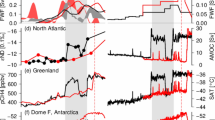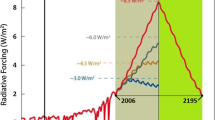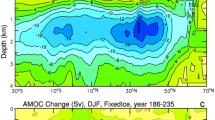Abstract
The response of the Atlantic Meridional Overturning Circulation (AMOC) to an increase in atmospheric CO2 concentration is analyzed using the IPSL-CM4 coupled ocean–atmosphere model. Two simulations are integrated for 70 years with 1%/year increase in CO2 concentration until 2×CO2, and are then stabilized for further 430 years. The first simulation takes land-ice melting into account, via a simple parameterization, which results in a strong freshwater input of about 0.13 Sv at high latitudes in a warmer climate. During this scenario, the AMOC shuts down. A second simulation does not include this land-ice melting and herein, the AMOC recovers after 200 years. This behavior shows that this model is close to an AMOC shutdown threshold under global warming conditions, due to continuous input of land-ice melting. The analysis of the origin of density changes in the Northern Hemisphere convection sites allows an identification as to the origin of the changes in the AMOC. The processes that decrease the AMOC are the reduction of surface cooling due to the reduction in the air–sea temperature gradient as the atmosphere warms and the local freshening of convection sites that results from the increase in local freshwater forcing. Two processes also control the recovery of the AMOC: the northward advection of positive salinity anomalies from the tropics and the decrease in sea-ice transport through the Fram Strait toward the convection sites. The quantification of the AMOC related feedbacks shows that the salinity related processes contribute to a strong positive feedback, while feedback related to temperature processes is negative but remains small as there is a compensation between heat transport and surface heat flux in ocean–atmosphere coupled model. We conclude that in our model, AMOC feedbacks amplify land-ice melting perturbation by 2.5.











Similar content being viewed by others
References
Cubasch U et al (2001) Third assessment report of climate change, chap 8. Intergovernmental panel on climate change. Cambridge University Press, Cambridge, p 572
Delworth T, Manabe S, Stouffer R (1993) Interdecadal variations of the thermohaline circulation in a coupled Ocean–Atmosphere model. J Climate 6:1993–2011
Fichefet T, Poncin C, Goosse H, Huybrechts P, Jansses I, Treut HL (2003) Implication of changes in freshwater flux from the Greenland ice sheet for the climate of the 21st century. Geophys Res Lett 30:1911
Forster P, Taylor K (2006) Climate forcings and climate sensitivities diagnosed from coupled climate model integrations. J Climate 19:6181–6194
Ganachaud A, Wunsch C (2000) Improved estimates of global ocean circulation, heat transport and mixing from hydrographic data. Nature 407:453–457
Gregory JM et al (2005) A model intercomparison of changes in the Atlantic thermohaline circulation in response to increasing atmospheric CO2 concentration. Geophys Res Lett 32:L12703
Gregory J, Saenko O, Weaver A (2003) The role of the Atlantic freshwater balance in the hysteresis of the meridional overturning circulation. Clim Dyn 21:707–717
Guilyardi E (2006) El Nino-mean state-seasonal cycle interactions in a multi-model ensemble. Clim Dyn 26:329–348
Hansen J, Lacis A, Rind D, Russell G, Stone P, Fung I, Ruedy R, Lerner J (1984) Climate sensitivity: analysis of feedback mechanisms. Clim Process Clim Sensitivity 29:130–163
Hu A, Meehl G, Washington W, Dai A (2004) Response of the Atlantic thermohaline circulation to increased atmospheric CO2 in a coupled model. J Climate 17:4267–4279
Hughes T, Weaver A (1994) Multiple equilibria of an asymetric 2-basin ocean model. J Phys Oceanogr 24:619–637
Jungclaus J, Haak H, Esch M, Roeckner E, Marotzke J (2006) Will Greenland melting halt the thermohaline circulation? Geophys Res Let 33: Art. No. L17708
Latif M, Roeckner E, Mikolajewicz U, Voss R (2000) Tropical stabilisation of the thermohaline circulation in a greenhouse warming simulation. J Clim 13:1809–1813
Marti O, et al. (2005) The new IPSL climate system model: IPSL-CM4. Note du pôle de modélisation n 26. ISSN 1288-1619, 88 pp, http://www.dods.ipsl.jussieu.fr/omamce/IPSLCM4/DocIPSLCM4/
Meehl GA, Washington WM, Arblaster JM, Bettge TW, Strand WG (2000) Anthropogenic forcing and decadal climate variability in sensitivity experiments of twentieth- and twenty-first-century climate. J Clim 13:3728–3744
Parizek BR, Alley RB (2004) Implications of increased Greenland surface melt under globalwarming scenarios: ice-sheet simulations. Quat Sci Rev 23:1013–1027
Overpeck J, Otto-Bliesner B, Miller G, Muhs D, Alley R, Kiehl J (2006) Paleoclimatic evidence for future ice-sheet instability and rapid sea-level rise. Science 311:1747–1750
Rahmstorf S (1996) On the freshwater forcing and the transport of the Atlantic thermohaline circulation. Clim Dyn 12:799–811
Rahmstorf S et al (2005) Thermohaline circulation hysteresis: a model intercomparison. Geophys Res Let 32: Art. No. L23605
Ridley J, Huybrechts P, Gregory J, Lowe J (2005) Elimination of the Greenland ice sheet in a high CO2 climate. J Climate 18:3409–3427
Stommel H (1961) Thermohaline convection with two stable regimes of flow. Tellus 13:224–230
Stouffer R et al (2006) Investigating the causes of the response of the thermohaline circulation to past and future climate changes. J Climate 19:1365–1387
Stouffer R, Manabe S (1999) Response of a coupled ocean–atmosphere model to increasing atmospheric carbon dioxide: sensitivity to the rate of increase. J Climate 12:2224–2237
Straub D (1996) An inconsistency between two classical models of the ocean buoyancy driven circulation. Tellus A 48:477–481
Swingedouw D, Braconnot P, Marti O (2006) Sensitivity of the Atlantic Meridional Overturning Circulation to the melting from Northern glaciers in climate change experiments. Geophys Res Lett 33:L07711
Swingedouw D, Braconnot P, Delecluse P, Guilyardi E, Marti O (2007) The impact of global freshwater forcing on the thermohaline circulation: adjustment of North Atlantic convection sites in a CGCM. Clim Dyn 28:291–305
Thorpe R, Gregory J, Johns T, Wood R, Mitchell J (2001) Mechanisms determining the atlantic thermohaline circulation response to greenhouse gas forcing in a non-flux-adjusted coupled climate model. J Climate pp 3102–3116
Vellinga M, Wood R, Gregory J (2002) Processes governing the recovery of a perturbed thermohaline circulation in HadCM3. J Climate 15:764–780
Voss R, Mikolajewicz U (2001) Long-term climate changes due to increased CO2 concentration in the coupled atmosphere–ocean general circulation model ECHAM3/LSG. Clim Dyn 17
Wood RA, Keen AB, Mitchell JFB, Gregory JM (1999) Changing spatial structure of the thermohaline circulation in response to atmospheric CO2 forcing in a climate model. Nature 399:572–575
Yang J, Neelin J (1993) Sea-ice interaction with the thermohaline circulation. Geophys Res Lett 20:217–220
Acknowledgments
We thank Alessandro Tagliabue who kindly proofread the manuscript. We gratefully acknowledge the constructive comments from Ron Stouffer and two other anonymous reviewers. The coupled simulations were carried out on the NEC SX6 of the Centre de Calcul de Recherche et Technologie (CCRT). This work was supported by the Commissariat a l’Energie Atomique (CEA), and the Centre National de la Recherche Scientifique (CNRS). It is a contribution to the European project ENSEMBLES (Project No GOCE-CT-2003-505539).
Author information
Authors and Affiliations
Corresponding author
Rights and permissions
About this article
Cite this article
Swingedouw, D., Braconnot, P., Delecluse, P. et al. Quantifying the AMOC feedbacks during a 2×CO2 stabilization experiment with land-ice melting. Clim Dyn 29, 521–534 (2007). https://doi.org/10.1007/s00382-007-0250-0
Received:
Accepted:
Published:
Issue Date:
DOI: https://doi.org/10.1007/s00382-007-0250-0




